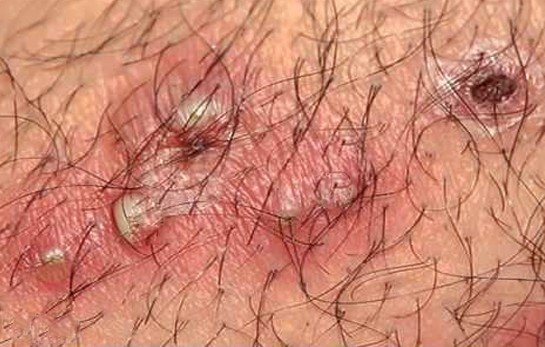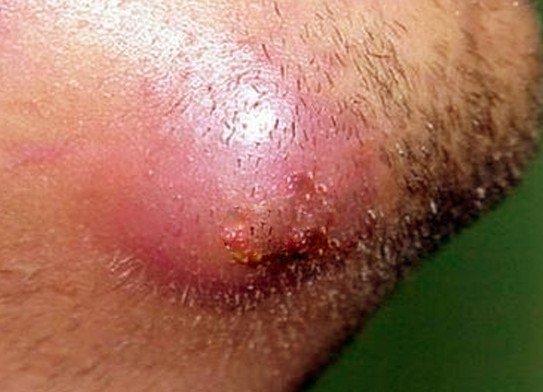Infected Ingrown Hair
Last reviewed by Dr. Raj MD on January 12th, 2022.
What to do for an Infected Ingrown Hair?
An infected hair is a short hair that has grown or curled back into a hair follicle instead of growing out. When this happens it can result in infection and inflammation. It is common to see this in teenagers when they start puberty and in young adults but can also happen to older adults. This condition is often seen in people who have coarse and curly hair.
Symptoms
When a person has an infected hair it most often appears as a raised red spot but when it is an infected ingrown hair these red spots turn into sores that are painful and filled with pus. They can even turn into boils, which is a deep localized skin infection that is also very painful. Other symptoms can include:
- Redness
- Inflammation
- Appearance of pustules, abscesses, and cysts, especially if it is a bad infection
- Mild to severe pain
- Irritation
- Skin rash
- Itchiness
- Tingling in the area of the infected ingrown hair
- Cluster of small bumps or one large bump
Causes of Infected Ingrown Hair
Having an infected ingrown hair is most commonly caused by shaving or waxing your arms, chest, back, pubic area, legs, face, and underarms. It can also be caused by wearing very tight clothes. When you have a hair removal procedure that leaves dead skin cell debris and excessive oil behind they can clog your hair follicles and cause an infected ingrown hair. Blunt or dirty razors and bacteria on your skin can also cause this condition.
Pictures of Infected Ingrown Hair
Staph infected ingrown hair
Picture of infected ingrown hair cyst
Preventing an infected ingrown hair
Although it is important to know how to treat the infected ingrown hair it is also important that you know how to stop them from occurring in the first place.
- Make sure that you are shaving in the right direction
- Use a sharp, clean razor when shaving
- Use shaving creams or gels
- Moisturize your skin after you shave
- Do not put a lot of pressure on the area you are shaving
- Do not wear clothes that are too tight
- Exfoliate your skin before you shave can help to prevent an infected ingrown hair
What not to do when you have an infected ingrown hair
- If you have an infected ingrown hair on your leg, armpit, neck, or pubic area make sure that you do not wear clothes that are tight fitting and the clothes should be made with softer materials.
- Do not be aggressive with an infected ingrown hair because it can cause the inflammation and swelling to become worse.
- Do not pop the infected ingrown hair because it can spread the bacteria that have caused the infection and could cause them to swell more.
Treatment
If it is a mild infection it may clear up without any treatment. When you have an infected ingrown hair make sure that you avoid shaving the area during this time until the infection is cleared up. If there is mild inflammation you can use an over-the-counter anti-inflammatory cream like one percent hydrocortisone cream. If the area does not clear up in a few days you should see your physician.
If the infected ingrown hair is a bad infection such as it is deeply ingrown or huge infected hair follicle you will usually need to see your physician for treatment. To treat this type of infection your physician will give you a prescription for antibiotics. It may also include treating it with antibiotic creams, gels, or ointments.
Home remedies
- Dab the in-infected ingrown hair with some type of antiseptic like tea tree oil, aloe Vera, rubbing alcohol, benzyl peroxide, or witch hazel.
- Apply a moist hot washcloth on the area to help loosen the hair and promote drainage
- Clean the area gently with antibacterial soap using a sterile gauze pad
- Use a sugar scrub — mix one cup sugar, twenty drops of jojoba oil, and one half cup extra virgin olive oil and apply the scrub over the area
- Make sure that you are washing the area two times a day with warm water and an antibacterial soap to help kill the bacteria that is causing the infection.
How to remove an infected ingrown hair
Although you can remove an infected ingrown hair it is not recommended because it can cause damage to your skin and cause a scar. If you do decide to remove the hair make sure that you do not pluck the complete infected ingrown hair follicle out. Instead you should remove the tip of the hair from under the skin using a toothpick or tweezers that are sterilized to gently raise the hair out of your skin. Using either one, gently slip them below the loop of the ingrown hair where it goes back into your skin and lift it up slowly and gently. If you cannot get under the ingrown hair you can apply a hot washcloth to the area so the hair will rise to the surface so you can get under the hair to pull it up. Once you have the hair out do not pull it out but leave it alone. Make sure that you do not cut or break the skin where the infected ingrown hair is because it can lead to more infection along with more ingrown hairs. Apply over-the-counter antibiotic or antiseptic cream and cover with a bandage.
If it is a deep or huge infected ingrown hair you should see your physician as you may need to have a small incision made so the physician can get the ingrown hair out.


